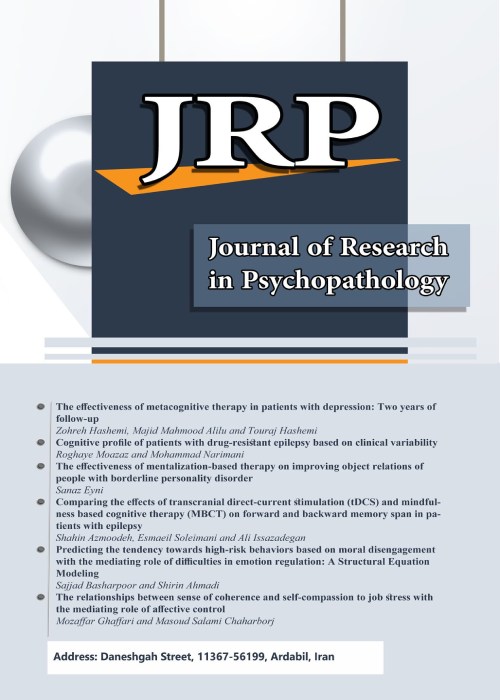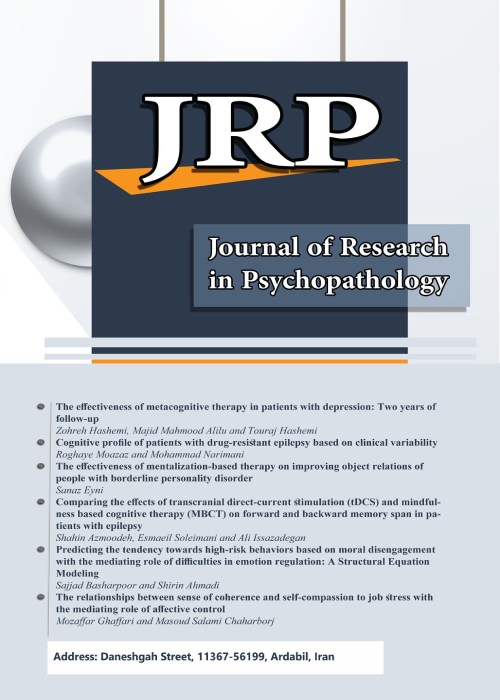فهرست مطالب

Journal of Research in Psychopathology
Volume:4 Issue: 13, Summer 2023
- تاریخ انتشار: 1402/05/10
- تعداد عناوین: 7
-
-
Pages 1-5Attention deficit/hyperactivity disorder is a very common disorder that is usually diagnosed in childhood. The present study was conducted with the aim of comparing mental indicators in mothers with hyperactive and normal children. The method of this research was causal-comparative. The population of the research included all mothers in Ardabil city in 2022. A sample of 50 mothers with hyperactive children were selected by availability sampling and 50 mothers with normal children were selected by purposive sampling from the relevant population as a comparison group and participated in the study. They answered the questionnaire of mental disorder and Connors parent rating scale in the presence of researchers. The collected data were also analyzed using descriptive statistics of mean, standard deviation, and multivariate analysis of variance through SPSS (25) software. The results of multivariate analysis of variance showed that there is a significant difference in average mental indices of interpersonal sensitivity (F = 11.512), depression (F = 127.956) and anxiety (F = 42.468) in mothers with hyperactive and normal children (p < 0.001). From a practical point of view, it is suggested that prevention strategies be taken to promote parents' mental health so that addressing parents' stress and anxiety can have long-term positive effects on children's health, well-being, and behavioral outcomes.Keywords: Mental indicators, hyperactivity, mothers
-
Pages 6-15
Although clinical findings support the significant effects of mindfulness and Transcranial Direct Current Stimulation (tDCS) on various disorders, especially Substance Use Disorder (SUD), their combined effect on methamphetamine addiction has not been investigated yet. This study examined the hypothesis of the combined effect of mindfulness+tDCS therapy on Attentional Bias (AB) towards drug-related stimuli and craving in adolescents with methamphetamine addiction. A total of 60 adolescents, with methamphetamine addiction were randomly assigned to the research groups, 20 people in each group with aged between 18 and 21 (mindfulness group, combined mindfulness + tDCS group, and sham group). The dorsolateral prefrontal cortex (DLPFC) was stimulated with at DCS device with an intensity of 1.5 mA for 12 sessions of 20 minutes, and for psychological intervention the 12 sessions of 50 minutes mindfulness-based substance abuse treatment (MBSAT) was trained (2 sessions per week). AB and craving were measured before the intervention, after the 12 sessions and at one-month follow-up. The results showed that the combined mindfulness-tDCS therapy group was more effective in the modification of AB towards drug-related stimuli in 200 ms and 500 ms and craving. It was also observed that there is a significant relationship between attention bias and reduction in craving.The findings supported the increased effectiveness of tDCS combined with psychological intervention in the modification of AB towards drug-related stimuli and craving in adolescents with methamphetamine addiction.
Keywords: Attentional bias, tDCS, mindfulness, Substance Use Disorder, adolescents -
Pages 16-28
Corona anxiety has had a penetrating effect on various aspects of people's lives and has led to psychological confusion and lack of regulation of emotions. The aim of the present study was to investigate the role of cognitive regulation of emotion and mental disturbances in predicting anxiety of corona in students. The research method was qualitative-quantitative. First, the cognitive regulation factors of emotion were investigated using the qualitative method (phenomenology). 317 people were selected from the statistical population of Payam Noor Urmia students by available sampling method.In coding, biological factors with 110 open codes, strategic factors with 83 open codes, intrapersonal factors with 71 open codes, and environmental factors with 63 open codes, couple factors with 46 open codes, respectively, are the priority of the cognitive emotion regulation factors in students. they came . And there was a direct relationship between the cognitive regulation of emotion identified and the cognitive regulation of emotion among Payam Noor in students.To predict corona anxiety, students responded to Alipour, et al.'s (2019), cognitive emotion regulation, and Garnoski, et al. (2001) psychological disorder scales (DASS-42).There was a Significant negative and positive correlation between the emotional regulation of adaptive and non-adaptive strategy with Corona anxiety, respectively. There was a Significant negative and positive correlation between emotional regulation of adaptive and non-adaptive strategies with psychological disturbance, respectively.. There was a Significant positive Correlation between mental disorder and corona anxiety. Regression analysis showed that these three components together explain 54% of Corona anxiety in students.
Keywords: Cognitive Regulation of Emotion, Psychological Disturbances, anxiety, Corona -
Pages 29-36Background
In recent years, infidelity and its effects on the family system have become the focus of psychological research more than ever.
ObjectivesThe current research was conducted with the aim of investigating the effectiveness of mindfulness on early maladaptive schemas of abandonment, stubborn criteria, mistrust and defectiveness in the betrayed women in Karaj in 2021.
MethodsThe method of his study was semi-experimental with pre-test and post-test design. The total number of women was 122 who had referred to Mehr Aria Psychology Clinic in Karaj. The pretest, post test, and follow-up were conducted with all participants, who were randomly placed in two groups: the experimental and control groups, which each consisted of 30 people. We provided eight mindfulness-based cognitive therapy (MBCT) session for only the experimental group.
ResultsAfter MANCOVA was conducted, the results showed that there was a significant difference between the mean of Early Maladaptive Schemas of Abandonment, stubborn criteria, mistrust and defectiveness in pre-test and post-test (P<0.05). Also, that there was a significant difference between the mean of Early Maladaptive Schemas of Abandonment, stubborn criteria, mistrust and defectiveness in follow up pre-test (P<0.05).
Keywords: mindfulness, early maladaptive schemas, abandonment, stubborn criteria, betrayed women -
Pages 37-42
The aim of this study was to investigate the effectiveness of group poetry therapy an improving happiness in chronic schizophrenic patients.
Materials and MethodsThis experimental study was conducted with a pre-test-post-test design with the control group. The statistical population consisted of patients hospitalized in treatment and rehabilitation centers in Ardabil (2017). Among them, 22 patients were selected from among these individuals and randomly assigned to experimental and control groups. Eleven sessions of group poetry were performed for the experimental group and the control group did not receive any intervention. Oxford happiness questionnaire was used to collect data and data were analyzed by single variable Covariance analysis on SPSS-22.
ResultsThe results showed that after controlling the pre-test effect, the mean scores of post-test Patients in the experimental group were higher in happiness than the scores of the control group (P<0.05), This indicates the effectiveness of group poetry therapy intervention on patients.
ConclusionThis study showed that group poetry therapy as a non-pharmacological treatment is effective on chronic schizophrenic patients and can be used by clinical specialists in medical centers.
Keywords: Schizophrenia, poetry therapy, happiness -
Pages 43-50
In recent years, the study of neuropsychology has played a significant role in explaining the symptoms of borderline personality disorder. Therefore, the purpose of this study was to model the relationship between cognitive defusion and problem-solving, considering the mediating role of metacognitive awareness in individuals with borderline personality disorder. The statistical population of this research included all individuals with borderline personality disorder in the Kurdistan province, aged between 18 and 60 years, during the years 2020 and 2021. A purposive sampling method was employed, following the "Kline" rule, and a total of 234 individuals were selected from this population. The participants completed the Cognitive Fusion Questionnaire by Gillanders et al. (2014), the Metacognitive Awareness Inventory by Schraw & Dennison (1994), and the Social Problem Solving Inventory by D'Zurilla & Nezu (2002). The collected data were analyzed using structural equation modeling in Amos-22 software. The results of this research confirm the model of the mediating role of metacognitive awareness in the relationship between cognitive defusion and problem-solving abilities in individuals with borderline personality disorder. Specifically, cognitive defusion directly and positively influences problem-solving skills (p<0.01, β=0.47), and metacognitive awareness also directly and positively affects problem-solving skills (p<0.01, β=0.19). Additionally, cognitive defusion indirectly affects problem-solving skills by influencing metacognitive awareness (p<0.05, β=0.07). These findings highlight the significance of both cognitive defusion and metacognitive awareness in predicting and improving problem-solving abilities in individuals with borderline personality disorder.
Keywords: Cognitive Defusion, Metacognitive awareness, problem solving, Borderline personality disorder -
Pages 51-75
The purpose of this study was to evaluate emotion-focused cognitive-behavioral therapy (ECBT) on test anxiety components in students with specific learning disorder (SLD). This research was an experimental study with the pre and post-test with a control group design. The statistical population of the present study was all fourth to sixth grade elementary students of two learning disabilities centers under the supervision of education in district 2 of Rasht who had referred to improve their learning disabilities and were studying in the academic year 2018-2019. Research sample included 30 students with specific learning disorder (SLD) who were selected through available sampling and classified into two groups: experimental group (n=20 subjects) and control group (n=20 subjects). For data collection we used Brooks (2015) test anxiety questionnaire. The results of maltivariate analysis of Covariance (MANCOVA) showed the emotion-focused cognitive-behavioral therapy was effective in reducing the components of test anxiety in students with specific learning disorder. Based on the obtained results, it can be said that emotion-focused cognitive-behavioral therapy can decrease the test anxiety of these students by making changes in inconsistent cognitive thoughts and distortions and using emotion regulation techniques.
Keywords: specific learning disorder, test anxiety, Emotion-focused cognitive-behavioral therapy


